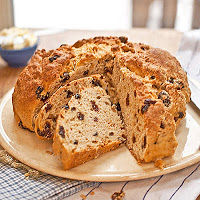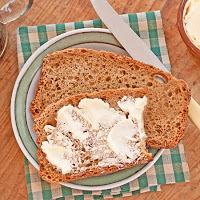 “Do you test your recipes?” This is the first question people usually ask when they hear I write cookbooks. I always answer, “Yes!” though some do look skeptical. (I suspect these peeps have been burned by untested recipes in the past.) Sometimes, I have to test and tweak a lot to make the grade with my best critic, my hubby. “It’s good enough for me to eat, but not good enough to go in a cookbook!” he often says. And he’s usually right about this!
“Do you test your recipes?” This is the first question people usually ask when they hear I write cookbooks. I always answer, “Yes!” though some do look skeptical. (I suspect these peeps have been burned by untested recipes in the past.) Sometimes, I have to test and tweak a lot to make the grade with my best critic, my hubby. “It’s good enough for me to eat, but not good enough to go in a cookbook!” he often says. And he’s usually right about this!
The other popular question, “Where do you get your recipes?” is tougher. As people often say of relationships: “It’s complicated.” Take the German Green Herb and Potato Soup here. It just sort of evolved and emerged from about a dozen ideas rattling around since I first made and got hooked on Julia Child’s Potage Parmentier, a classic French potato-leek soup back in the early 1970s. FYI, Parmentier was a French horticulturist born in 1737; his name is always a tip-off a dish contains potatoes.)
 A few years later when my family lived in Germany I discovered a traditional heavily herbed early springtime potato soup called “Grüne Suppe, Frankfurter Art,” (meaning Green Soup, Frankfurt Style). Assorted fresh green herbs not only contributed a distinct green color but wonderfully savory fresh vegetable flavor to the local seasonal specialty. Another bit of inspiration came in Denmark when I ate boiled potatoes heavily sprinkled with fresh chopped dillweed. They were just terrific.
A few years later when my family lived in Germany I discovered a traditional heavily herbed early springtime potato soup called “Grüne Suppe, Frankfurter Art,” (meaning Green Soup, Frankfurt Style). Assorted fresh green herbs not only contributed a distinct green color but wonderfully savory fresh vegetable flavor to the local seasonal specialty. Another bit of inspiration came in Denmark when I ate boiled potatoes heavily sprinkled with fresh chopped dillweed. They were just terrific.
I think you get the picture! This recipe (like many) is somehow drawn from a whole grab bag of culinary samplings, experiences, kitchen experiments and know-how amassed over the decades. (For another, totally different but equally good potato soup, you can try this curried version.)
 German Green Herb and Potato Soup
German Green Herb and Potato Soup
To pare down the prep time and get this very tasty soup on the table a bit faster, I call for leftover mashed potatoes. It’s even possible to use purchased, ready-to-serve mashed potatoes. They will do just fine.
You do need to remove the coarse stems from the dillweed and parsley and use only the leaves though. The stems are too tough to produce a pleasant texture.
Of course, the color makes this soup a perfect choice for St. Paddy’s Day, but frankly it is great for any cool weather meal. In the left side of the pic above, you can see the edge of a slice of Irish soda bread, likewise an appropriate option if you’re interested in marking the occasion in a traditional fashion. Another possibility–my Guinness Extra Stout no-knead bread is here.
chopped
chicken broth
chopped dillweed and parsley leaves (no stems)
fresh chives, plus more for garnish
each regular milk and light cream)
1 1/2 to 2 cups leftover mashed potatoes, as needed
Salt and freshly ground black pepper to taste
In a 4-quart saucepan or similar-size soup pot, melt the butter over medium-high heat. Add the onion and cauliflower and cook, stirring, about 3 minutes, until the onion softens but does not begin to brown. Add 1 1/2 cups broth; adjust heat so the mixture simmers and cook for 5 minutes, then set aside.
In a food processor, combine the herbs and cornstarch and pulse until the herbs are finely chopped. Scoop up 2 cups of cauliflower mixture (drain the excess broth back into the pot) and add vegetable mixture to the processor. Process until the herbs are finely chopped and
the mixture well blended and as smooth as possible. Add the pureed mixture back to the pot, along with the remaining 2 1/2 cups broth.
Bring back to a boil, and cook, stirring, until slightly thickened, about 3 to 4 minutes. Whisk in the half-and-half and 1 1/2 cup mashed potatoes until smoothly and evenly incorporated. For a thicker soup, whisk in more potatoes as needed. Taste and add salt and pepper if desired. Return the soup to the stove, and heat, stirring to piping hot. Serve garnished with chopped chives and sprigs of dillweed, if desired. Makes 1 1/2 quarts of soup, 4 or 5 main dish servings.
Fine accompaniments to this soup recipe: Guinness stout bread, left, and Irish soda bread, right. Or perhaps you’d like my curried potato soup instead of this one.




Soup looks lovely and sounds delicious. I'll wait for the chives and dill to come up in the herb garden beneath my breakfast room window. I know it's to be served piping hot, but how would it be if served chilled in summer–as in a vichyssoise?
Elizabeth, I don't know the answer. There has always been some notion that recipes were just to be passed around–that nobody owned them and that is not really the case. I believe according to copyright law, that nobody can own the particular formula of specific group of ingredients set forth in a recipe. HOWEVER, the author certainly owns the text–that is, the name of the recipe, any intro remarks, and the text that tells how to make the dish. Peeps MUST at least write the recipe in their own words or they are plagiarizing.
Amalgamating is indeed a reasonable, acceptable way to go–in terms of getting ideas and seeing what approaches are taken by other recipe developers. Before I had my own large data base of personally created and tested recipes, I did that, and still do look to see what's on the Web. But often Web searches reveal that with slightly unusual dishes, they are all just minor riffs on the same one author's recipe–that those posting have done virtually nothing to make the dish their own.
When we are planning to have something new, we generally consult as many recipes for it as we can find – in our cookbooks and on the internet (because I'm afraid that both of us are almost incapable of following one recipe exactly) and then amalgamating all that we've read to come up with something similar but different.
I am amazed at the increasing number of recipes on the internet that are copied and pasted verbatim from another site. Who does that?! Were they ill or at the dentist on the day that plagiarism was being taught in school?
Dianne, I did say that, but, in fact, I can't make myself actually put anything that hasn't tested out well on the blog either! One thing I do occasionally do is borrow recipes from my own books and articles as a starting point. I normally find that my thinking has evolved since I did the recipe, or maybe I want to try a different flavor/spice combo, or maybe figure out how to make it quicker/easier. It seems perfectly okay to me to borrow from myself!
Nancy, I can't remember which post it was, but I'll never forget the time you said you decided to spend less time developing recipes for your blog than for your books.
I hope I've got this right. It makes sense to me. Not that this recipe is not accomplished — it is, of course — but just that you are a professional, so writing recipes and blogging is a little different for you.
Jamie and Elizabeth, I agree that it is a different issue when one posts on a blog as opposed to creates recipes for a cookbook. Blog recipes are free, and also, they can be changed readily. Readers and publishers have a right to be angry when cookbook recipes don't work–assuming they actually follow the author's instructions 🙂
Writing cookbooks has become more competitive than ever, so regular trade books, as opposed to community fund-raiser cookbooks, really need to work. Bad recipe reviews by disgruntled readers can deep-six a cookbook these days.
If I were writing a cookbook, I would definitely test each recipe several times (and get others to test as well). Is this not standard procedure? I would hope it would be! If it isn't standard procedure then hurrah for you and your integrity.
However, I confess that on my blog, we often make something once and it's so fabulous that we simply post what we did. When we make it again, it might not turn out exactly the same but we don't really care. It still tastes good, making it (as your husband so aptly said) "good enough […] to eat, but not good enough to go in a cookbook!"
I would never have thought of adding cauliflower to cream of potato soup. I love cauliflower but would have thought its flavour would take over the more delicate flavour of the potatoes. And yet, judging from the photo, your soup looks fabulous.
I have to say, Nancy, that I totally understand the readers question. How many times have I or friends made a recipe from a cookbook or cooking magazine or blog to have it totally fail? I find it stunning that untested recipes can be published. Okay, maybe on a blog someone posting something they have only made the once is understandable, and making something from any untrained home cook from a blog is a risk, although maybe it shouldn't be? But coming from a professional it would be unforgiveable. Thank YOU for sharing with us your own process (I know from your cookbook how perfect your recipes are) I also love your husband's comment! Good for him! And btw – my husband makes his grating with a combo of cauliflower and potatoes…
Rebecca, I, too, feel like I'm offering something extra by posting my own recipes. The only time I feel really comfortable using other people's work is when I'm showcasing their cookbook. Then it makes sense to me, as I'm emphasizing what's in their book!
Very tempting. As you know, I love soup and love making it. And I don't understand why people would want to put other people's recipes in their blog. If I put a recipe in my blog, which I do occasionally, it's something I created myself.
Yum, I'm off to the supermarket to buy cauliflower and fresh herbs.
Louise Donaldson290
Oh gosh, this looks so-o-o-o good. I think I'll have to make it. Like now!
That sounds yummy. I love garlicky cauliflower "faux mashed potatoes", so cauliflower in this soup sounds perfect. I'll have to try this recipe.
I agree–he has said that a lot over the years and I always laugh. And it makes it so clear that he "gets" what I'm doing!
"It's good enough for me to eat, but not good enough to go in a cookbook!"
Love that so, so much.